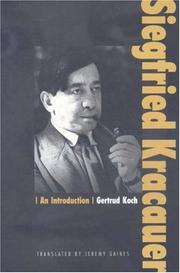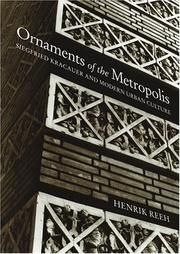| Listing 1 - 5 of 5 |
Sort by
|

ISBN: 0691049920 0691016135 1400823641 9786612767043 1282767046 1400812399 9781400812394 9781400823642 9781282767041 9780691016139 9780691049922 140081684X Year: 2000 Publisher: Princeton, N.J. Princeton University Press
Abstract | Keywords | Export | Availability | Bookmark
 Loading...
Loading...Choose an application
- Reference Manager
- EndNote
- RefWorks (Direct export to RefWorks)
Siegfried Kracauer has been misunderstood as a naïve realist, appreciated as an astute critic of early German film, and noticed as the interesting exile who exchanged letters with Erwin Panofsky. But he is most widely thought of as the odd uncle of famed Frankfurt School critical theorists Jürgen Habermas, Theodor Adorno, Walter Benjamin, and Max Horkheimer. Recently, however, scholars have rediscovered in Kracauer's writings a philosopher, sociologist, and film theorist important beyond his associations--and perhaps one of the most significant cultural critics of the twentieth century. Gertrud Koch advances this Kracauer renaissance with the first-ever critical assessment of his entire body of work. Koch's analysis, which is concise without sacrificing thoroughness or sophistication, covers both Kracauer's best-known publications (e.g., From Caligari to Hitler, in which he gleans the roots of National Socialism in the films of the Weimar Republic) and previously underexamined texts, including two newly discovered autobiographical novels. Because Kracauer's wide-ranging works emerge from no rigidly unified approach, instead always remaining open to unusual and highly individual perspectives, Koch resists the temptation to force generalization. She does, however, identify recurring tropes in Kracauer's lifetime effort to perceive the basic posture and composition of particular cultures through their visual surfaces. Koch also finds in Kracauer a surprisingly contemporary cultural commentator, whose ideas speak directly to current discussions on film, urban modernity, feminism, cultural representation, violence, and other themes. This book was long-awaited in Germany, as well as widely and well reviewed. Now translated into English for the first time, it will fuel already growing interest in the United States, where Kracauer lived and wrote from 1941 until his death in 1966. It will attract the attention of students and scholars working in Film Studies, German Studies, Comparative Literature, Critical Theory, Cultural Studies, Philosophy, and History.
Motion pictures. --- Kracauer, Siegfried, --- Criticism and interpretation. --- Germany --- Intellectual life --- Cinema --- Feature films --- Films --- Movies --- Moving-pictures --- History and criticism --- Ginster, --- Kracauer, S. --- Krakauėr, Z. --- Krakauėr, Zigfrid --- Audio-visual materials --- Mass media --- Performing arts
Book
ISBN: 3768199827 Year: 1987 Volume: 27 Publisher: Marbach am Neckar Deutsche Schillergesellschaft
Abstract | Keywords | Export | Availability | Bookmark
 Loading...
Loading...Choose an application
- Reference Manager
- EndNote
- RefWorks (Direct export to RefWorks)
Authors, German --- Ecrivains allemands --- Correspondence --- Correspondance --- Benjamin, Walter, --- Kracauer, Siegfried, --- -German authors --- Benjamin, Walter --- -Kracauer, Siegfried --- -Benjamin, W. --- Correspondence. --- -Correspondence --- Ginster, --- Kracauer, S. --- Krakauėr, Z. --- Krakauėr, Zigfrid --- Benjamin, W. --- Holz, Detlef, --- Banyaming, --- Benʼyamin, Varutā, --- Peñcamin̲, Vālṭṭar, --- Binyamin, Ṿalṭer, --- בנימין, ולטר --- בנימין, ולטר, --- ולטר, בנימין, --- Penyamin, Palt'ŏ, --- 벤야민 발터,

ISBN: 0262182378 0262681633 9780262182379 9780262681636 Year: 2004 Publisher: Cambridge (Mass.) MIT press
Abstract | Keywords | Export | Availability | Bookmark
 Loading...
Loading...Choose an application
- Reference Manager
- EndNote
- RefWorks (Direct export to RefWorks)
Variations on the theme of the ornament in Kracauer's urban writings, suggesting ways in which the subjective can reappropraite urban life.For Siegfried Kracauer, the urban ornament was not just an aspect of design; it was the medium through which city dwellers interpreted the metropolis itself. In Ornaments of the Metropolis, Henrik Reeh traces variations on the theme of the ornament in Kracauer's writings on urbanism, from his early journalism in Germany between the wars to his "sociobiography" of Jacques Offenbach in Paris. Kracauer (1889-1966), often associated with the Frankfurt School and the intellectual milieu of Walter Benjamin, is best known for his writings on cinema and the philosophy of history. Reeh examines Kracauer's lesser-known early work, much of it written for the trendsetting newspaper Frankfurter Zeitung in the 1920s and early 1930s, and analyzes Kracauer's continuing reflections on modern urban life, through the pivotal idea of ornament. Kracauer deciphers the subjective experience of the city by viewing fragments of the city as dynamic ornaments; an employment exchange, a day shelter for the homeless, a movie theater, and an amusement park become urban microcosms.Reeh focuses on three substantial works written by Kracauer before his emigration to the United States in 1940. In the early autobiographical novel Ginster, Written by Himself, a young architect finds aesthetic pleasure in the ornamental forms that are largely unused in the profession of the time. The collection Streets of Berlin and Elsewhere, with many essays from Kracauer's years in Berlin, documents the subjectiveness of urban life. Finally, Jacques Offenbach and the Paris of His Time shows how the superficial—in a sense, ornamental—milieu of the operetta evolved into a critical force during the Second Empire. Reeh argues that Kracauer's novel, essays, and historiography all suggest ways in which the subjective can reappropriate urban life. The book also includes a series of photographs by the author that reflect the ornamental experience of the metropolis in Paris, Frankfurt, and other cities.
Architecture and society --- Urban beautification. --- History --- 711.4 --- Kracauer, Siegfried --- Stedenbouw --- Kracauer, Siegfried, --- Criticism and interpretation. --- Photographie --- Analyse de l'architecture --- Design --- Image de la ville --- Sociologie urbaine --- Ecrit d'artiste --- Offenbach, Jacques --- Urban beautification --- Beautification of cities and towns --- Cities and towns --- City beautification --- Embellisement (Urban renewal) --- Embellishment, Urban --- Embellissement (Urban renewal) --- Urban embellishment --- City planning --- Urban policy --- Urban renewal --- Beautification --- Ginster, --- Kracauer, S. --- Krakauėr, Z. --- Krakauėr, Zigfrid --- 316.334.56 --- Urbane sociologie --- Stedenbouw (theorie)
Book
ISBN: 074560188X Year: 1985 Publisher: Cambridge Polity press
Abstract | Keywords | Export | Availability | Bookmark
 Loading...
Loading...Choose an application
- Reference Manager
- EndNote
- RefWorks (Direct export to RefWorks)
Sociology of culture --- Simmel, Georg --- Kracauer, Siegfried --- Benjamin, Walter --- Culture --- Modernism (Aesthetics) --- Modernisme (Esthétique) --- Philosophy --- Philosophie --- Benjamin, Walter, --- Kracauer, Siegfried, --- Simmel, Georg, --- Views on modernism (Aesthetics) --- -Cultural sociology --- Civilization --- Aesthetics --- Social aspects --- -Kracauer, Siegfried --- -Benjamin, Walter --- -Benjamin, W. --- Philosophy. --- Modernism (Aesthetics). --- -Philosophy --- -Views on modernism (Aesthetics) --- Modernisme (Esthétique) --- Zimmelʹ, Georg, --- Zimmelʹ, G. --- Simmel, G. --- זימל, גיאורג, --- Jinmeru, Georuku, --- Ginster, --- Kracauer, S. --- Krakauėr, Z. --- Krakauėr, Zigfrid --- Benjamin, W. --- ジムメル, ゲオルク --- Holz, Detlef, --- Banyaming, --- Benʼyamin, Varutā, --- Peñcamin̲, Vālṭṭar, --- Binyamin, Ṿalṭer, --- בנימין, ולטר --- בנימין, ולטר, --- ולטר, בנימין, --- Penyamin, Palt'ŏ, --- 벤야민 발터,
Book
ISBN: 3963178450 3963172991 9783963172991 9783963178450 Year: 2022 Publisher: Büchner-Verlag
Abstract | Keywords | Export | Availability | Bookmark
 Loading...
Loading...Choose an application
- Reference Manager
- EndNote
- RefWorks (Direct export to RefWorks)
In his doctoral dissertation, Christoph Seelinger provides an overview of strategies for legitimizing and functionalizing documentary death scenes in narrative cinema. Seelinger's chronological arc begins with the earliest animal deaths on camera, such as the filmed execution of the female elephant Topsy in »Electrocuting an Elephant – Thomas A. Edison« (1903), and it continues to the glossy snuff videos of the Islamic State's media department in the 2010s. Between these two poles, the author – with the same academic scrutiny – looks at established arthouse films, but all also at countless representations of station cinema that have been dismissed as trash and exploitation and have so far eluded academic research. The result is a foray through the more ostracized regions of cinema history and, in the process, nothing less than the first detailed history of the intrusion of real depictions of death into the fiction of the feature film. Christoph Seelinger liefert in seiner Promotionsschrift einen Überblick über Legitimations- und Funktionalisierungsstrategien dokumentarischer Toten- und Todesszenen im Erzählkino. Seelingers chronologischer Bogen beginnt bei den frühesten animalischen Toden vor laufender Kamera wie beispielsweise der filmisch festgehaltenen Hinrichtung des Elefantenweibchens Topsy in »Electrocuting an Elephant – Thomas A. Edison« (1903) und er führt bis zu den Hochglanz-Snuff-Videos der Medienabteilung des Islamischen Staates in den 2010er Jahren. Zwischen diesen beiden Polen betrachtet der Autor mit derselben medienwissenschaftlichen Hinwendung arrivierte Arthouse-Filme, vor allem aber auch zahllose als Trash und Exploitation abqualifizierte Vertreter des Bahnhofskinos, die einem akademischen Zugriff bislang entzogen waren. Das Ergebnis ist ein Streifzug durch die verfemteren Regionen der Kinogeschichte und dabei nichts weniger als die erste auführliche Geschichte des Einbruchs realer Todesdarstellungen in die Fiktion des Spielfilms.
Experimental films --- Humanities --- Benjamin, Walter, --- Kracauer, Siegfried, --- Germany --- death and cinema --- death and photography --- snuff films --- death in film --- Learning and scholarship --- Classical education --- Avant-garde films --- Experimental videos --- Personal films --- Underground films --- Motion pictures --- Video art --- Ginster, --- Kracauer, S. --- Krakauėr, Z. --- Krakauėr, Zigfrid --- Banyaming, --- Benjamin, W. --- Benʼyamin, Varutā, --- Binyamin, Ṿalṭer, --- Holz, Detlef, --- Peñcamin̲, Vālṭṭar, --- Penyamin, Palt'ŏ, --- Alemania --- Ashkenaz --- BRD --- Bu̇gd Naĭramdakh German Uls --- Bundesrepublik Deutschland --- Deguo --- Deutsches Reich --- Deutschland --- Doitsu --- Doitsu Renpō Kyōwakoku --- Federal Republic of Germany --- Federalʹna Respublika Nimechchyny --- FRN --- Gėrman --- German Uls --- Germania --- Germanii︠a︡ --- Germanyah --- Gjermani --- Grossdeutsches Reich --- Jirmānīya --- KhBNGU --- Kholboony Bu̇gd Naĭramdakh German Uls --- Nimechchyna --- Repoblika Federalin'i Alemana --- República de Alemania --- República Federal de Alemania --- Republika Federal Alemmana --- Vācijā --- Veĭmarskai︠a︡ Respublika --- Weimar Republic --- Weimarer Republik --- Germany (East) --- Germany (West) --- Europe --- Film theory & criticism --- Film: styles & genres --- Death and cinema; Mondo; experimental cinema; death and photography; grindhouse; Walter Benjamin; genre cinema; crossing borders; transgression; Siegfried Kracauer; Georges Bataille; dying in film; snuff; fairground cinema; exploitation cinema; staging death; film history; death scenes; death in film
| Listing 1 - 5 of 5 |
Sort by
|

 Search
Search Feedback
Feedback About
About Help
Help News
News